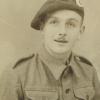"We were at Chaklala in North West India. I was an R.A.F. Airgunner then, flying as a passenger with an R.C.A.F. crew. The Canucks were on a special exercise with a mixed stick of twenty British and Punjabi paratroopers of an Airborne R.A.M.C. unit.
We took off at ten to eight one morning—sorry, 0750 hrs to you !—and from "Emplane" to "Go" everything went like clockwork. After the last man had hurtled away from the door of the Dakota I stooped to help the jumpmaster, a young Canadian Warrant-Officer, to pull in the static-lines and bags flapping in the slipstream.
The next moment will always remain stamped indelibly on my memory.... There, swinging behind the aircraft with deadly uncertainty, on a static-line, was a man tangled up in his webbing straps. I looked again to make certain. Then my back went cold and my mouth felt dry. In a few moments all the crew knew what had happened. We pulled in the loose lines and bags, but even four of us, straining hard on the unfortunate paratrooper's static-line, simply could not haul the wretched thing in at all. The line stayed taut as ever and would not budge. Where the line entered the aircraft it had worked under the bottom of the large closed door next to the jumping-exit. And there it was wedged. We could not haul effectively on the line from inside the 'plane. The only way to haul the line in was to reach round from the exit and heave on the part of the line outside the fuselage. But there was room for only one man to grasp the line from the exit.
The pilot throttled back almost to stalling speed. We struggled in turn with every effort we knew how to make. But no one man was strong enough to haul the paratrooper back into the safety of the 'plane. Then, to our horror, we could see the line starting to fray where it entered the 'plane. The situation grew more desperate with every second. I still remember the awful feeling of helplessness and the thought that there seemed absolutely nothing else we could do to save the man at the other end of that fraying line. He was in a slipstream more violent than the worst hurricane; he was being hammered against the fuselage; he was spinning sickeningly now... .
We had been flying round the D.Z. in large circles and there was a fairly wide river nearby. The Captain decided to fly as low and as slowly over the river as we safely could so that the paratrooper would stand some chance of survival though only a slender one—when the webbing finally parted. But by this time the man had been hanging perilously for nearly twenty minutes and seemed unconscious.
Suddenly someone had an idea and we clutched it like a drowning man at a straw. We tied the entrance steps to the 'plane securely to a spare static-line and swung them out from the exit so that they hooked over the wedged and fraying line just aft of where it entered the fuselage. With a mighty effort we managed to inch the line free from under the door—and the four of us tugged with seared hands and pounding hearts. The steps were caught precariously on the frayed line and, if they had slipped, the line would certainly have jerked taut and as certainly snapped.
Fortunately they held and after minutes of tenacious straining the paratrooper had been hauled near enough to the exit for us to be able to grasp his webbing and drag him, dazed and panting, into the 'plane. What then? After recovering sufficiently to be able to speak, the paratrooper grinned and mumbled apologies for the inconvenience he had caused us ! Can you beat it? Just another reason why airmen think well of airborne troops". . . E.G.G.
And for disbelieving readers' we must add that the author can produce his log book with a certified entry to support the truth of this story.
This article is reproduced from the Pegasus Journal Volume II Number 4 January 1948. Compiled for ParaData by Harvey Grenville
Source:
Originally published in the Pegasus Journal January 1948.
Read More




Latest Comments
There are currently no comments for this content.
Add Comment
In order to add comments you must be registered with ParaData.
If you are currently a ParaData member please login.
If you are not currently a ParaData member but wish to get involved please register.